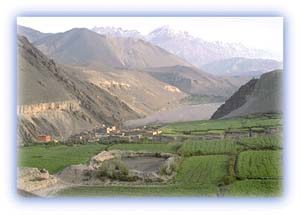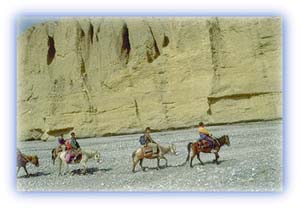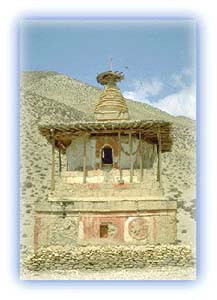Nepal Himalayas
General Info
· Solo Khumbu
· Namche Bazar
· Thyangboche
· Pangboche
· Kalapattar
· Pheriche
· Buddhism in Khumbu
· People: Sherpas
· Mount Everest
· The Quest for Everest
· Early Years
· The 1950s
· Sherpas on Everest
Mustang
· Jomsom
· People: Thakalis
· Muktinath
· Manang valley
· Bryagu village
· Manang village
· Nyasang Division
· Western Nepal
· Jumla
· Sukhadik
Photo Feature:
· Annapurna region
High Altitude Sickness
Endangered Species
Protected Areas
Yaks
The Yeti Factor

![]()
|
Central Nepal The Central Nepal region consists of the Mustang area, Jomsom, Muktinath, and the Manang Valley. This region was not opened to foreigners till 1977. The area had in fact been used by the Khampa rebels as a base in their attempts to free Tibet from Chinese occupation. |
 |
| Valley of the Kali Gandaki Credit: Stan Armington |
A well-known rebel, Wangdi, had established his base camp about 6 to 7 km from Jomsom as it was the closest point to Lhasa and had a climate and terrain similar to that of the Tibetan plateau. He enjoyed a lot of sympathy among the locals, till the Nepalese government, bowing to Chinese demands, sent its army into the area, annihilated the base and killed him. Since then, the army had maintained a permanent presence in the area and had been conducting regular courses in mountaineering and rock climbing for its personnel.
The Nepalese in this region are however generally in favor of a gradual transition to a democratic system and are making efforts to bring themselves closer to the King.
 |
| On the Kali Gandaki riverbed in Mustang Credit: Stan Armington |
Mustang Region
Mustang is the name given to the arid region at the northern
end of the Kali Gandaki. Locally, Mustang is known as Lo and it
is believed that the word Mustang (pronounced moo-stang) is a
mispronunciation of the capital of Lo -- Manthang. Officially,
the district of Mustang extends along the Kali Gandaki from the
Tibetan border in the north to Ghasa further south. The capital
of the Mustang District is Jomsom. North of Kagbeni is a region
of Tibetan influence called Upper Mustang. Upper Mustang
consists of two distinct regions. The southern region, with
five villages, is inhabited by people related to the Manangis -
- the inhabitants of the Manang Valley. The northern region is
the location of the ancient kingdom of Lo, where the language,
culture and traditions are almost purely Tibetan. The capital
of Lo is Manthang, which, in Tibetan, means "plain of
aspiration".
 |
| Buddhist chorten in Mustang Credit: Stan Armington |
The Mustang Bhote region boasts a famous pilgrimage center: Muktinath. The climate and landscape here are similar to those of the Tibetan Plateau since it is situated in the rain shadow of the Greater Himalayas. Flowing through the region from north to south and forming deep gorges is the Kali Gandaki river, which as its name implies (kali = black) is a black river --the black stones of the riverbed and black soil contributing to the effect.
Scattered in the region are villages like Jhang, Jharkot, Kagbeni and Khingar, which cluster around the streams that make cultivation possible. These green patches are the only oases in this otherwise desolate "desert". In Kagbeni, "saligrams" are common. They are small, round, fossilized stones, which are easily recognizable by the presence of a conical eye on the surface. When broken, they are generally found to contain fossils. They are considered to be "blessed" by the cosmic power responsible for the universe as we know it. More importantly, they are proof that the Himalayas at one time were under a deep sea.
 |
| Mustang -- the forbidden city. It was opened to outsiders only recently. Credit: Stan Armington |
Most of the people are Buddhists. They are a versatile and aggressive lot but very hospitable to their guests. They neither bury nor cremate their dead. Instead, amidst the chanting of mantras, the lamas cut the bodies into pieces and spread them out for the vultures. They owe allegiance to a local "King", who collects revenues from them and submits these to the King of Nepal. For his efforts, this man has been given the rank of colonel in the Nepalese army. The people trade regularly with Tibet, bartering yak butter, ghee and salt for rice, clothes and other consumer durables.
All rights reserved